Technical and Economic Feasibility of Cold Ironing in Italy: A Detailed Case Study
Abstract
1. Introduction
2. High-Voltage Shore Connection (HVSC) Systems
3. Determining the Cost of a Stopover with Cold Ironing
3.1. ARERA
- Transmission (TRAS): “The TRAS tariff covers the costs of transporting electricity on the national transmission grid. It is applied to all end customers, with the exception of low-voltage domestic users. The TRAS tariff consists of a component expressed in euro cents/kWh (TRASE) and a component expressed in euro cents/kW of committed power capacity (TRASP), the latter applied only to high or very high voltage users.” [10].
- Distribution (DISTR): “The mandatory tariff for distribution services covers the costs of transporting electricity on distribution networks. It applies to all end customers, with the exception of low-voltage domestic users. The tariff has a three-part structure and is expressed in euro cents per point of delivery per year (fixed charge), euro cents per kW per year (power charge) and euro cents per kWh consumed (energy charge).” [11].
- Measurement (MIS): “The MIS tariff is intended to cover the costs of installing and maintaining the meter, as well as the costs of reading and recording the measurements. It is applied to all end customers, with the exception of low-voltage domestic users. The tariff is expressed in euro cents per kWh consumed for public lighting and low-voltage users supplying public electric vehicle charging infrastructure, and in euro cents per withdrawal point per year for all other uses” [12].
- General system charges: “In addition to sales services (raw materials, marketing and sales), network services (transport, distribution, meter management) and taxes, electricity bills also include certain components to cover costs for activities of general interest to the national electricity system: these are known as general system charges, introduced over time by specific regulatory measures. In recent years, general system charges have represented a growing and increasingly significant share of end users’ total annual electricity expenditure. Starting in 2018 (Resolutions 481/2017/R/eel and 922/2017/R/eel), the rates of general charges to be applied to all types of contracts are divided into:
- ○
- ASOS: general costs relating to the support of renewable energy and cogeneration;
- ○
- ARIM: remaining general expenses;
- ○
- UC3: to cover imbalances in the compensation systems for electricity transmission costs on transmission and distribution networks, as well as integration mechanisms, expressed in euro cents/kWh.
- ○
- UC6: to cover recognised costs arising from service quality improvements. It is expressed in euro cents/kW and euro cents/kWh for domestic users, while for other users it is expressed in euro cents/pp and euro cents/kWh.” [13].
- Discounts are directly applied to electricity bills from the POD to which the Cold Ironing (IdC) infrastructure is connected. The discounted values of the OGS tariff components would then be applied to the bill (ex-ante approach, similar to what already happens today under the current subsidy scheme for energy-intensive businesses). This approach would be easily applicable by ARERA only where the POD is dedicated exclusively to powering IdC.
- The Cold Ironing Infrastructure Manager (GdI) would pay the OGSs the ‘full’ rate in the bill and recover the discounts to which it is entitled through a periodic refund received from CSEA, based on reports prepared by the GdI (ex-post approach, similar to what happened under the first mechanism for facilitating energy-intensive companies, pursuant to Ministerial Decree 5/4/2013). This approach would allow ARERA to discount only the portion of energy sold to the ship, leaving the plant operator to bear the general system charges for the portion of energy withdrawn but not exchanged.
3.2. Gestore Mercati Energetici (GME)—Energy Market Operator
- The Forward Electricity Market (MTE), where contracts for the future delivery of electricity are traded. In this particular market, participants (producers, distributors, and industrial and institutional consumers) can enter into agreements to buy or sell a specific quantity of electricity at a predetermined price for a future date. This type of market is often used for risk management, energy cost stabilisation and long-term planning purposes.
- The Spot Market (MPE) is divided into the Day-Ahead Market (MGP), the Intra-Day Market (MI), the Daily Products Market (MPEG), and the integrated scheduling process (MSD). Most energy is traded on the MGP through hourly auctions (managed by Euphemia, a centralised European algorithm) and delivered the following day. These auctions stipulate the following:
- Sales bids are ordered by ascending price, thus creating the supply curve;
- Purchase bids are ordered by descending price, thus producing the demand curve.
3.2.1. Cost of Participating in the Italian Electricity Market
3.2.2. Amount Requested by an Italian Electricity Trader
3.3. Management Models
3.3.1. Model No. 1
3.3.2. Model No. 2
- The “one-off” fee, already paid in advance by the trader in order to carry out their activity, was disregarded.
- Only part of the annual fixed cost (totalling EUR 10,000) was imposed on the management of the cold ironing plant; this is in accordance with the following equation, where E1 represents the energy purchased on the electricity market by the supplier to be resold/used in the “traditional” course of its business [TWh/year], and E2 is the energy purchased only for the management of the cold ironing system alone [TWh/year]:
3.3.3. Model No. 3
3.4. Additional Expenditure Items
4. Cost of a Standard Stopover
4.1. Specific Fuel Oil Consumption (SFOC)
4.1.1. Influence of the Lower Calorific Value of the Fuel and Construction Tolerance
4.1.2. Influence of Temperature and Load
4.1.3. Other Influencing Factors
- Engine ageing;
- Performance of the various devices downstream of the engine;
- Type of engine [24];
- Distribution losses in the ship’s internal network.
4.1.4. SFOC Assessment
4.2. Fuel Price
- Marine Gas Oil—MGO (S% ≤ 0.1%);
- Very Low Sulphur Fuel Oil—VLSFO (S% ≤ 0.5%);
- Intermediate Fuel Oil—IFO (S% ≤ 1%).
4.3. Cost of Emissions
- CO2(V) indicates the aggregate CO2 emissions of all journeys made between ports under the jurisdiction of a Member State;
- CO2(S) indicates emissions occurring at berth in ports under the jurisdiction of a Member State;
- CO2(P) indicates the aggregate CO2 emissions of all legs of the journey, departing from ports under the jurisdiction of a Member State;
- CO2(A) indicates the aggregate CO2 emissions of all legs of the journey to ports under the jurisdiction of a Member State.
- For 2025: A total of 40% of their emissions reported in 2024;
- For 2026: A total of 70% of their emissions reported in 2025;
- For 2027 onwards: A total of 100% of their reported emissions [34].
5. Case Study
5.1. Assessment of Energy Demand
- In 2026, only 80% of ships will be equipped with the necessary systems for connection;
- In 5% of cases, the connection will not be established for various reasons (e.g., unavailability of ship or shore-side equipment, operational requirements decided by the Captain, maintenance activities, etc.);
- Given the ongoing increase in cruise traffic, it is estimated that there will be a 2% increase in moorings compared to 2025.
5.2. Plant Performance
5.3. Summary of the Data Supporting the Analysis
5.4. Additional Relevant Aspects
- Switching off the engine;
- Reduced noise and vibrations for passengers and crew;
- Better air quality;
- A reduction in localised pollution.
5.4.1. Reduced Maintenance
5.4.2. Reduction in Fuel Required for the Journey
- The amount of fuel needed to power the ship while moored was calculated in tonnes (T1);
- The amount of fuel required for the ship to move 1 tonne for 1 kilometre was calculated in tonnes (T2);
- The quantity calculated in the previous point is multiplied by the number of kilometres travelled by the ship from a generic port of departure to the port under analysis;
- The calculated fuel quantity is multiplied by the fuel price.
5.4.3. Cost of Implementing the Ship-Side Electrification System
5.4.4. Penalty for Failure to Connect
6. Results of the Analysis
- Analysis 1: The occurrence of all conditions favourable to the sustainability of the plant (Section 6.1);
- Analysis 2: The complete absence of cold ironing incentive policies (Section 6.2).
6.1. Analysis 1—Existing Regulatory Framework
- The three dotted lines (which represent the cost of electricity supplied from the port to the ship). This cost depends on the cost of electricity on the market (PUN) and the specific characteristics of the economic models considered for the provision of the cold ironing service (the management models are represented by three different colours);
- The three solid lines (which represent the cost of self-producing electricity on board the ship, in relation to the type of fuel and the variation in its cost).
6.2. Analysis 2—Absence of Cold Ironing Incentive Policies
6.3. Analysis 3—Influence of the Amount of Electricity Sold for Cold Ironing
7. Conclusions
Author Contributions
Funding
Data Availability Statement
Conflicts of Interest
Abbreviations
| AC | Alternating Current |
| AdSP | Italian acronym of “Autorità di Sistema Portuale”—Port System Authority |
| AMP | Alternative Maritime Power |
| ARERA | Italian acronym of “Autorità di Regolazione per Energia Reti e Ambiente”—Regulatory Authority for Energy, Networks, and Environment |
| CEB | Italian acronym of “Cabina Elettrica di Banchina”—MV Substation |
| CMS | Cable Management System |
| CSEA | Italian acronym of “Cassa per i Servizi energetici e Ambientali”—Fund for Energy and Environmental Services |
| DPF | Delay Power Factor |
| ECA | Emission Control Area |
| ETS | Emissions Trading System |
| GdI | Italian acronym of “Gestore di Infrastruttura di Cold Ironing”—OPS’s Infrastructure Manager |
| GME | Italian acronym of “Gestore Mercati Energetici”—Energy Market Operator |
| HVSC | High-Voltage Shore Connection |
| IdC | Italian acronym of “Infrastruttura di Cold Ironing”—OPS’s Infrastructure |
| IFO | Intermediate Fuel Oil |
| IMO | International Maritime Organisation |
| JB | Junction Box |
| LCV | Lower Calorific Value |
| LVSC | Low Voltage Shore Connection |
| MGO | Marine Gas Oil |
| MGP | Italian acronym of “Mercato del giorno prima”—Day-Ahead Market |
| MI | Italian acronym of “Mercato infragiornaliero”—Intra-Day Market |
| MPE | Italian acronym of “Mercato a pronti”—Spot Market |
| MPEG | Italian acronym of “Mercato dei prodotti giornalieri”—Daily Products Market |
| MSD | Italian acronym of “Mercato del servizio di dispacciamento”—Integrated Scheduling Process |
| MTE | Italian acronym of “Mercato a termine”—Forward Electricity Market |
| OPS | On-shore Power Supply |
| OGS | Italian acronym of “Oneri Generali di Sistema”—General System Charges |
| PUN | Italian acronym of “Prezzo Unico Nazionale”—National Single Price |
| SFOC | Specific Fuel Oil Consumption |
| VLSFO | Very Low Sulphur Fuel Oil |
References
- Vaca-Cabrero, J.; González-Cancelas, N.; Quijada-Alarcón, J. Bayesian Networks Applied to the Maritime Emissions Trading System: A Tool for Decision-Making in European Ports. Inventions 2025, 10, 28. Available online: https://www.mdpi.com/2411-5134/10/2/28 (accessed on 17 April 2025). [CrossRef]
- CO2 Emissions from Shipping–Encouraging the Use of Low-Carbon Fuels. Available online: https://ec.europa.eu/info/law/better-regulation/have-your-say/initiatives/12312-CO2-emissions-from-shipping-encouraging-the-use-of-low-carbon-fuels_en (accessed on 2 January 2025).
- Fit for 55: Increasing the Uptake of Greener Fuels in the Aviation and Maritime Sectors. Available online: https://www.consilium.europa.eu/en/infographics/fit-for-55-refueleu-and-fueleu/ (accessed on 12 December 2024).
- European Parliament, Committee on Transport and Tourism, Provisional Agreement Resulting from Interinstitutional Negotiations. Article 5. pp. 56–61. Available online: https://www.europarl.europa.eu/meetdocs/2014_2019/plmrep/COMMITTEES/TRAN/AG/2023/05-24/1278138EN.pdf (accessed on 26 April 2023).
- Canepa, M.; Ballini, F.; Dalaklis, D.; Frugone, G.; Sciutto, D. Cold Ironing: Socio-Economic Analysis in the Port of Genoa. Logistics 2023, 7, 28. Available online: https://www.mdpi.com/2305-6290/7/2/28 (accessed on 13 April 2025). [CrossRef]
- Nigro, M.; De Domenico, M.; Murgia, T.; Stimilli, A. The Port Sector in Italy: Its Keystones for Energy-Efficient Growth. Energies 2024, 17, 1788. Available online: https://www.mdpi.com/1996-1073/17/7/1788 (accessed on 25 February 2025). [CrossRef]
- European Commission, Entec UK Ltd. Directorate General Environment, Service Contract on Ship Emissions: Assignment, Abatement and Market-Based Instruments—Task 2a: Shore-Side Electricity. Final Report. August 2005. Available online: https://sustainableworldports.org/wp-content/uploads/EU-Commission-Directorate-General-Enviroment.pdf (accessed on 15 September 2025).
- IEC/IEEE 80005-1; Utility Connections in Port—Part 1: High Voltage Shore Connection (HVSC) Systems—General Requirements. IEC/IEEE: Geneva, Switzerland, 2019.
- ARERA, Area Operatori Operators Login—Prezzi e Tariffe Prices and Fees. Available online: https://www.arera.it/area-operatori/prezzi-e-tariffe (accessed on 23 June 2025).
- ARERA, Area Operatori—Tariffa per il Servizio di Trasmissione Transmission service tariff. Available online: https://www.arera.it/area-operatori/prezzi-e-tariffe/tariffa-per-il-servizio-di-trasmissione (accessed on 23 June 2025).
- ARERA, Area operatori—Tariffe di Distribuzione Distribution Service Charges. Available online: https://www.arera.it/area-operatori/prezzi-e-tariffe/distr (accessed on 23 June 2025).
- ARERA, Area Operatori—Tariffa per il Servizio di Misura Metering Service Charge. Available online: https://www.arera.it/area-operatori/prezzi-e-tariffe/tariffa-per-il-servizio-di-misura (accessed on 23 June 2025).
- ARERA, Area Operatori—Oneri Generali di Sistema e Ulteriori Componenti General System Charges and Other Elements. Available online: https://www.arera.it/area-operatori/prezzi-e-tariffe/oneri-generali-di-sistema-e-ulteriori-componenti (accessed on 23 June 2025).
- ARERA, Consultazione Accessed 28 Maggio 2024—211/2024/R/eel. Available online: https://www.arera.it/atti-e-provvedimenti/dettaglio/24/211-24 (accessed on 21 June 2024).
- Gazzetta Ufficiale, Art. 48 del Decreto 76 al Comma 7-bis del 16 Luglio 2020 Official Journal, Article 48, Paragraph 7-bis of Decree-Law n. 76 of July 16, 2020. Available online: https://www.gazzettaufficiale.it/atto/serie_generale/caricaArticolo?art.versione=1&art.idGruppo=11&art.flagTipoArticolo=0&art.codiceRedazionale=20A04997&art.idArticolo=48&art.idSottoArticolo=1&art.idSottoArticolo1=10&art.dataPubblicazioneGazzetta=2020-09-29&art.progressivo=0 (accessed on 18 November 2024).
- De Forcade, R. Ok dell’Ue al Piano Italiano da 570 Milioni per Ridurre le Emissioni delle Navi EU Approves Italy’s €570 Million Plan to Reduce Ship Emissions. Il sole 24 ore 2024. Available online: https://www.ilsole24ore.com/art/ok-dell-ue-piano-italiano-570-milioni-ridurre-emissioni-navi-AG5nuub?refresh_ce=1# (accessed on 18 November 2024).
- Ue: Ok Aiuti per 570 Milioni Destinati a Incentivare il Cold Ironing nei Porti Italiani EU: €570 million in aid approved to promote cold ironing in Italian Ports. La Repubblica 2024. Available online: https://www.repubblica.it/economia/rapporti/energitalia/trasformazione/2024/06/19/news/ue_ok_aiuti_per_570_milioni_destinati_a_incentivare_il_cold_ironing_nei_porti_italiani-423256927/ (accessed on 17 November 2024).
- Commissione Ue: Ok per Aiuti di Stato a Cold Ironing EU Commission: Green Light for State Aid for Cold Ironing. AdriaPorts 2024. Available online: https://www.adriaports.com/it/logistica/commissione-ue-ok-per-aiuti-di-stato-a-cold-ironing/ (accessed on 17 November 2024).
- La Commissione Europea Approva il Regime di Sussidi per il “Cold Ironing” del Nostro Paese: Riduzione Fino al 100% Degli Oneri Generali di Sistema per Gli Operatori Navali Che Si Riforniscono dalle Reti Elettriche Terrestri The European Commission Approves Italy’s Subsidy Scheme for Cold Ironing: Up to 100% Reduction in General System Charges for Shipping Operators Who Connect to Shore-Side Electricity Networks. QualEnergia.it 2024. Available online: https://www.qualenergia.it/articoli/elettrificazione-porti-ue-via-libera-piano-italiano-570-milioni/#:~:text=La%20Commissione%20europea%20approva%20il,riforniscono%20dalle%20reti%20elettriche%20terrestri (accessed on 17 November 2024).
- ARERA, Deliberazione 22 Marzo 2022 Resolution of-117/2022/R/EEL. Table 4, pp. 15–16. Available online: https://www.arera.it/fileadmin/allegati/docs/22/117-22.pdf (accessed on 23 March 2025).
- Gazzetta Ufficiale Dell’unione Europea, Decisione di Esecuzione (UE) 2021/2058 del consiglio del 23 November 2021 Official Journal of the European Union, Council Implementing Decision (EU) 2021/2058 of 23 November 2021. Available online: https://eur-lex.europa.eu/legal-content/IT/TXT/HTML/?uri=CELEX:32021D2058&from=IT#d1e139-1-1 (accessed on 27 March 2025).
- Gazzetta Ufficiale, Art. 34-Bis Della Legge 8/2020 Official Journal, art. 34-bis of Law 8/2020. Available online: https://www.gazzettaufficiale.it/atto/serie_generale/caricaArticolo?art.versione=1&art.idGruppo=2&art.flagTipoArticolo=0&art.codiceRedazionale=20A01353&art.idArticolo=34&art.idSottoArticolo=2&art.idSottoArticolo1=10&art.dataPubblicazioneGazzetta=2020-02-29&art.progressivo=0 (accessed on 27 March 2025).
- Gunes, U.; Ust, Y.; Sinan Karakurt, A. Performance Analysis of Turbocharged 2-Stroke Diesel Engine; ResearchGate GmbH: Berlin, Germany, 2015; Available online: https://www.researchgate.net/publication/281203659_Performance_Analysis_of_Turbocharged_2-Stroke_Diesel_Engine (accessed on 13 November 2024).
- Jalkanen, J.-P.; Johansson, L.; Kukkonen, J.; Brink, A. Extension of an Assessment Model of Ship Traffic Exhaust Emissions for Particulate Matter and Carbon Monoxide; ResearchGate GmbH: Berlin, Germany, 2011; Available online: https://www.researchgate.net/publication/252392578_Extension_of_an_assessment_mode_of_ship_traffic_exhaust_emissions_for_particulate_matter_and_carbon_monoxide (accessed on 11 November 2024).
- Il Mediterraneo Raggiunge un Traguardo Storico Nell’impegno per una Navigazione Meno Inquinante The Mediterranean Reaches a Historic Milestone in Its Commitment to Cleaner Shipping. Ambiente Ma Non Solo… 2023. Available online: https://ambientenonsolo.com/il-mediterraneo-raggiunge-un-traguardo-storico-nellimpegno-per-una-navigazione-meno-inquinante/ (accessed on 12 November 2024).
- Il Mediterraneo Sarà Area ECA del 1° Maggio 2025 The Mediterranean Will Become an ECA Area on 1 May 2025. Ship2Store 2022. Available online: https://www.ship2shore.it/it/il-mediterraneo-sara-area-eca-del-1-maggio-2025 (accessed on 12 November 2024).
- Martinuzzi, M. Il Mediterrano è Diventato “Area Eca”. Regole più Severe per le Emissioni Delle Navi The Mediterranean Has Become an ‘ECA Area’. Stricter Rules for Ship Emissions. IL SECOLO XIX 2025. Available online: https://www.ilsecoloxix.it/blue-economy/energia/2025/05/06/news/mediterrano_area_eca_emissioni_navi-15132925/ (accessed on 23 June 2025).
- Il Mediterraneo Incluso Nella Normativa Ambientale Seca The Mediterranean Included in the SECA Environmental Regulations. TE Trasporto Europa 2025. Available online: https://www.trasportoeuropa.it/notizie/marittimo/il-mediterraneo-incluso-nella-normativa-ambientale-seca/ (accessed on 23 June 2025).
- Zis, T. (DTU management engineering program at Danmarks Tekniske Universitet, Kongens Lyngby, Danmarks). Cold Ironing at Ports as an Emissions Reduction Option. Available online: https://backend.orbit.dtu.dk/ws/portalfiles/portal/162459347/The_prospects_of_cold_ironing_as_an_emissions_reduction_option_TRB_2018.pdf (accessed on 15 September 2025).
- Pezzi, G. Quanto è Aumentato il Petrolio, Con i grafici e la Serie Storica Oil Price Increases, with Graphs and Historical Data. QM QUOTIDIANO MOTORI 2022. Available online: https://www.quotidianomotori.com/automobili/prezzo-del-petrolio/ (accessed on 13 January 2025).
- SENDECO2, CO2 Prices. Available online: https://www.sendeco2.com/it/prezzi-co2 (accessed on 26 June 2024).
- Bellini, M. ETS Carbon Price: Quali Aspettative per il 2023 ETS Carbon Price: What to Expect in 2023. Nextwork360 2023. Available online: https://www.esg360.it/esg-smart-data/ets-carbon-price-quali-aspettative-per-il-2023/ (accessed on 27 June 2024).
- European Parliament. Revision of the EU Emissions Trading System. Available online: https://www.europarl.europa.eu/doceo/document/TA-9-2022-0246_EN.html (accessed on 28 October 2024).
- European Commission, Climate Action, Reducing Emissions from the Shipping Sector. Available online: https://climate.ec.europa.eu/eu-action/transport-decarbonisation/reducing-emissions-shipping-sector_en (accessed on 18 October 2024).
- Bacalja, B.; Krčum, M.; Slišković, M. A Line Ship Emissions while Manoeuvring and Hotelling—A Case Study of Port Split. J. Mar. Sci. Eng. 2020, 8, 953. Available online: https://www.mdpi.com/2077-1312/8/11/953 (accessed on 20 May 2024). [CrossRef]
- Mocerino, L.; Quaranta, F. How emissions from cruise ships in the port of Naples changed in the COVID-19 lock down period. SageJournals 2021, 236, 125–130. Available online: https://journals.sagepub.com/doi/full/10.1177/14750902211028421 (accessed on 20 November 2024). [CrossRef]
- Enel S.p.A. Comunicato Stampa. ENEL: Nel 2024 risultati solidi grazie alla positiva evoluzione del business integrato in Iberia e nelle Americhe Enel S.p.A. Press release. ENEL: Solid results in 2024 thanks to the positive development of the integrated business in Iberia and the Americas. Available online: https://www.enel.com/content/dam/enel-common/press/it/2025-marzo/Enel%20risultati%20FY%202024ITA.pdf (accessed on 16 November 2024).
- Available online: https://shipandbunker.com/prices (accessed on 18 July 2024).
- Banca d’Italia. Tassi di cambio—Cambi annuali Bank of Italy. Exchange Rates—Annual Exchange Rates. Available online: https://portale.unipv.it/sites/default/files/2024-04/Cambi%20Medi%20Annuali%202023.pdf (accessed on 8 November 2024).
- Scala, E.; Cozzi, A.; Carobolante, A.; Silvestri, S. Porto di Trieste—Piano d’azione per un porto sostenibile e a basse emissioni di CO2. Autorità di Sistema Portuale del Mar Adriatico Orientale 2018 Port of Trieste—Action Plan for a Sustainable, Low-CO2 Emission Port. Eastern Adriatic Sea Port System Authority 2018. Available online: https://www.assoporti.it/media/6857/deasp-adsp-mare-adriatico-orientale-2.pdf (accessed on 11 November 2024).
- Martinuzzi, M. Seaview, il Gigante da 800 Milioni Facile da Manovrare Seaview, the Easy-to-Manoeuvre 800-Million Giant. The MediTelegraph 2018. Available online: https://www.themeditelegraph.com/it/shipping/cruise-and-ferries/2018/06/07/news/seaview-il-gigante-da-800-milioni-facile-da-manovrare-1.38083216#:~:text=La%20generazione%20elettrica%20%C3%A8%20garantita,una%20velocit%C3%A0%20di%2022%20nodi (accessed on 8 October 2024).
- Abu Bakar, N.N.; Vasquez, J.C.; Bazmohammadi, N.; Othman, M.; Dalby Rasmussen, B.; Al-Turki, Y.A. Optimal Configuration and Sizing of Seaport Microgrids including Renewable Energy and Cold Ironing—The Port of Aalborg Case Study. Energies 2022, 15, 431. Available online: https://www.mdpi.com/1996-1073/15/2/431 (accessed on 11 March 2025). [CrossRef]
- Kelmalis, A.; Dimou, A.; Francis Lekkas, D.; Vakalis, S. Cold Ironing and the Study of RES Utilization for Maritime Electrification on Lesvos Island Port. Environments 2024, 11, 84. Available online: https://www.mdpi.com/2076-3298/11/4/84 (accessed on 11 March 2025). [CrossRef]

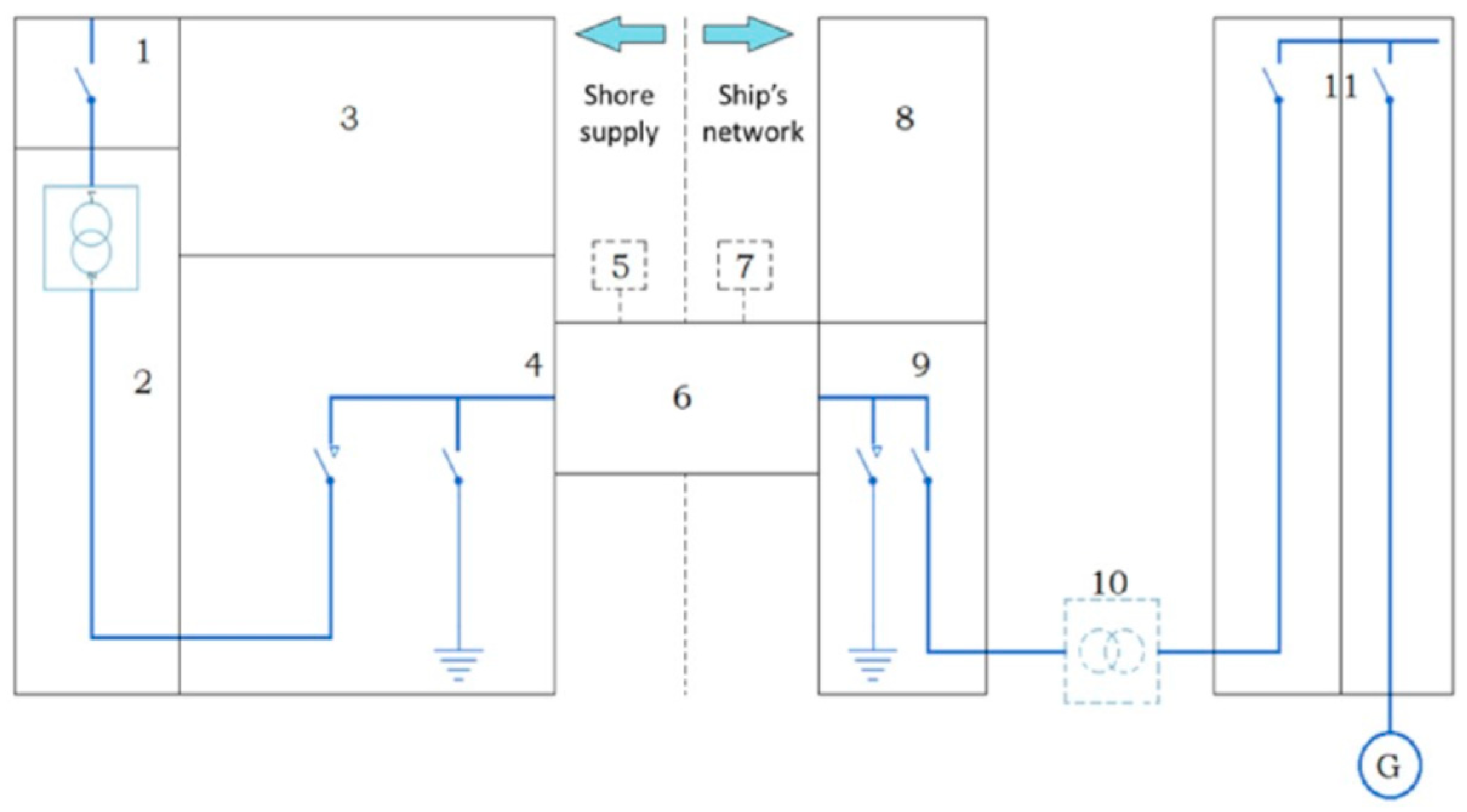

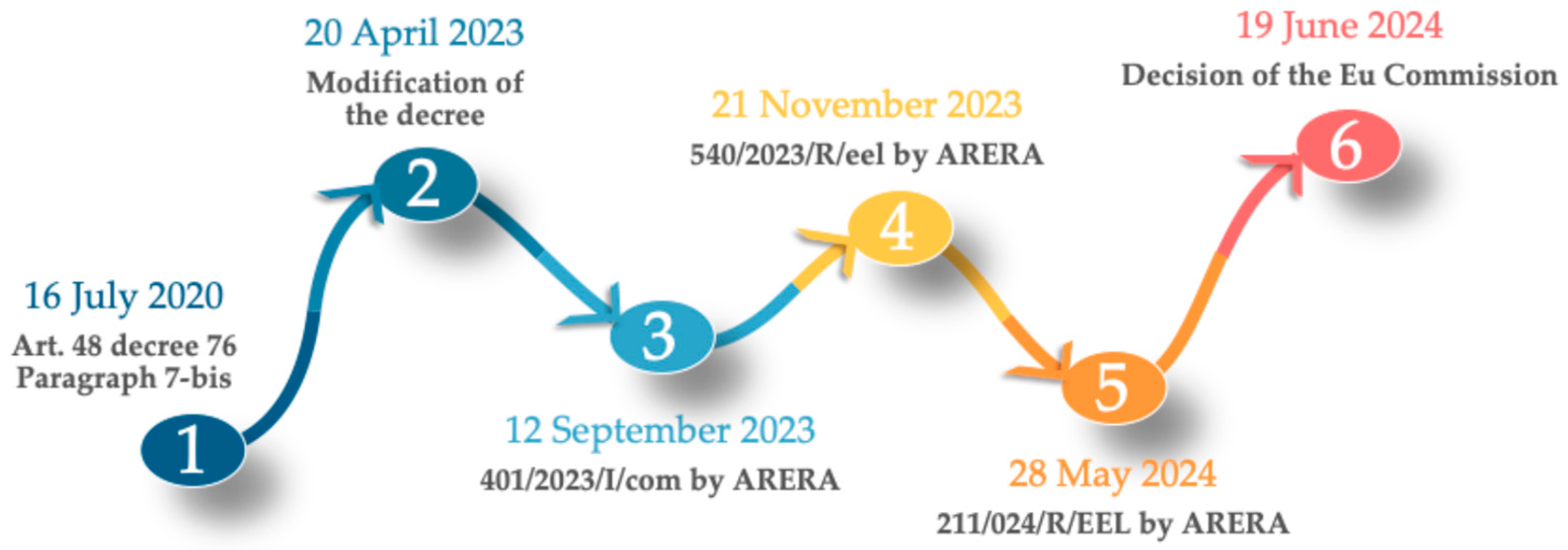





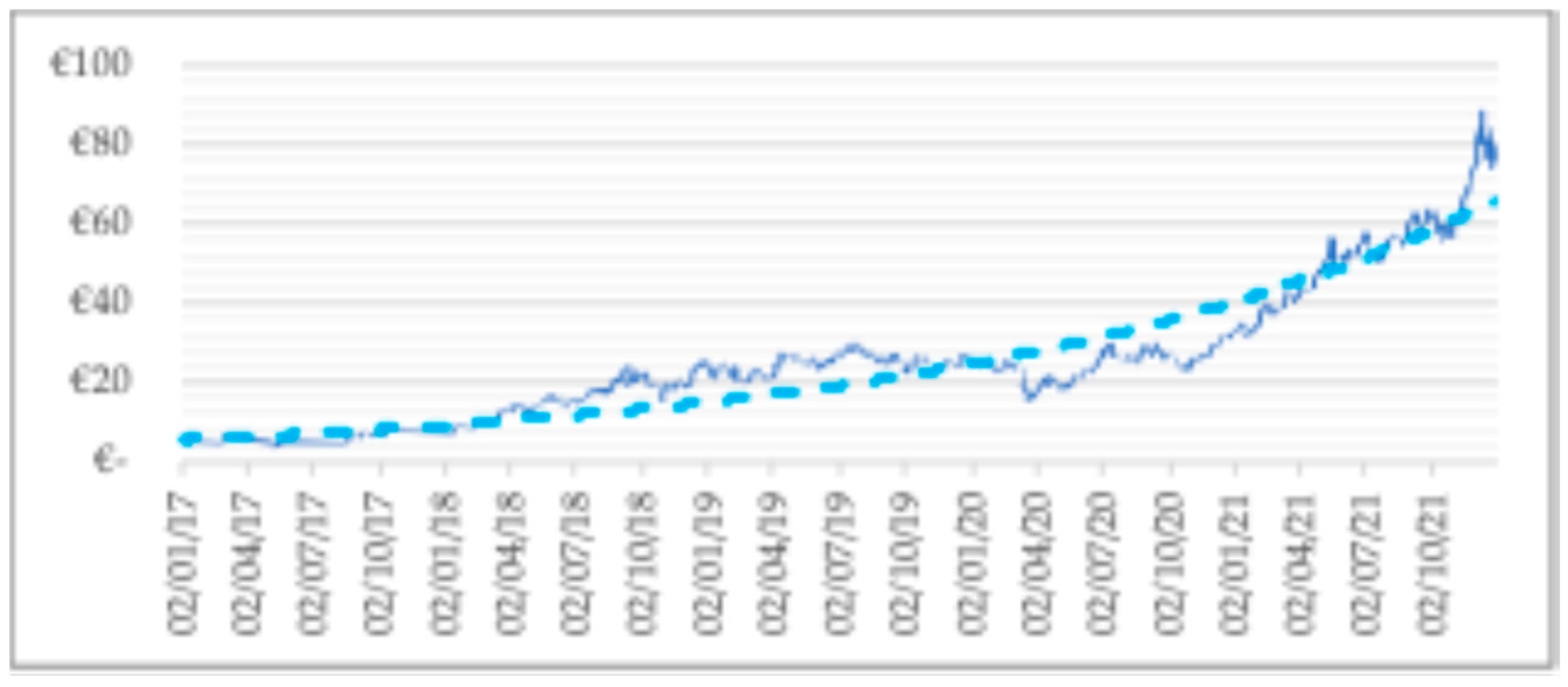
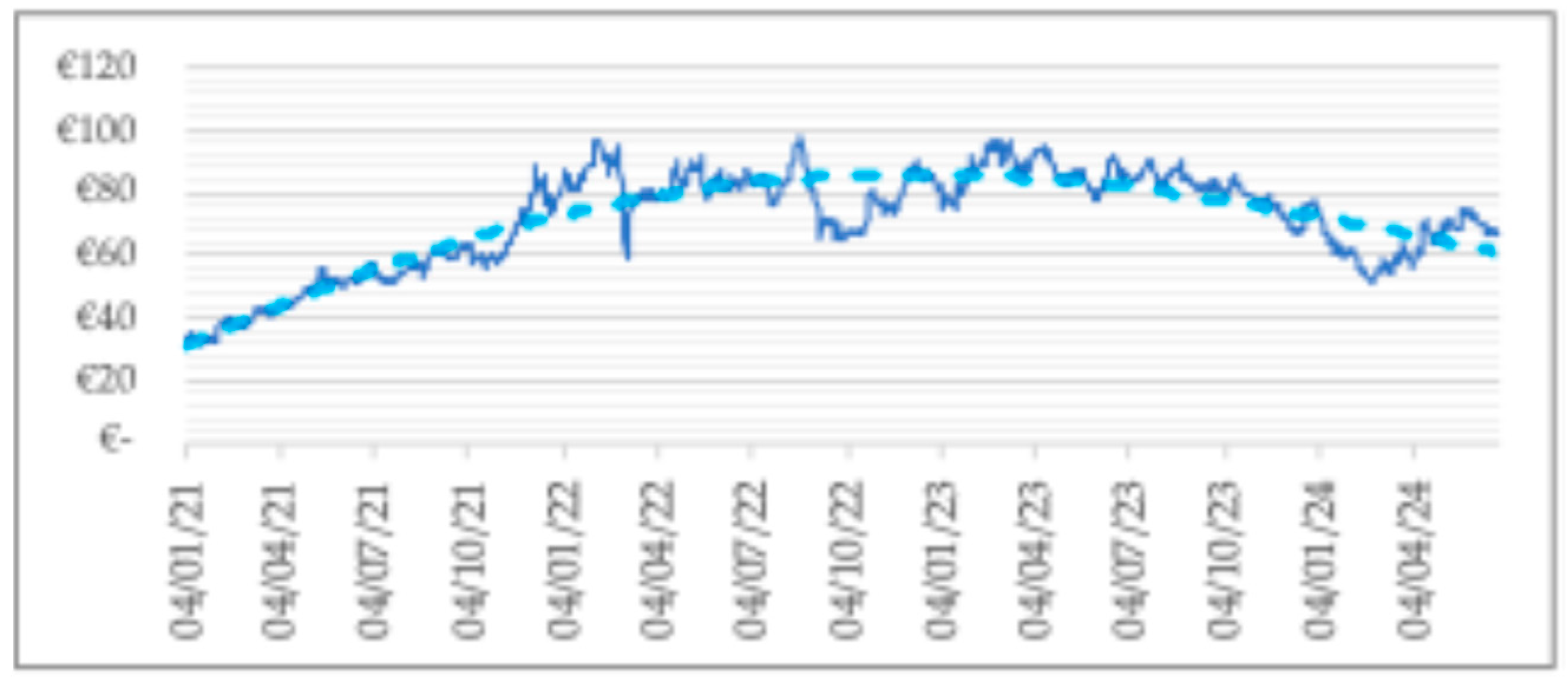


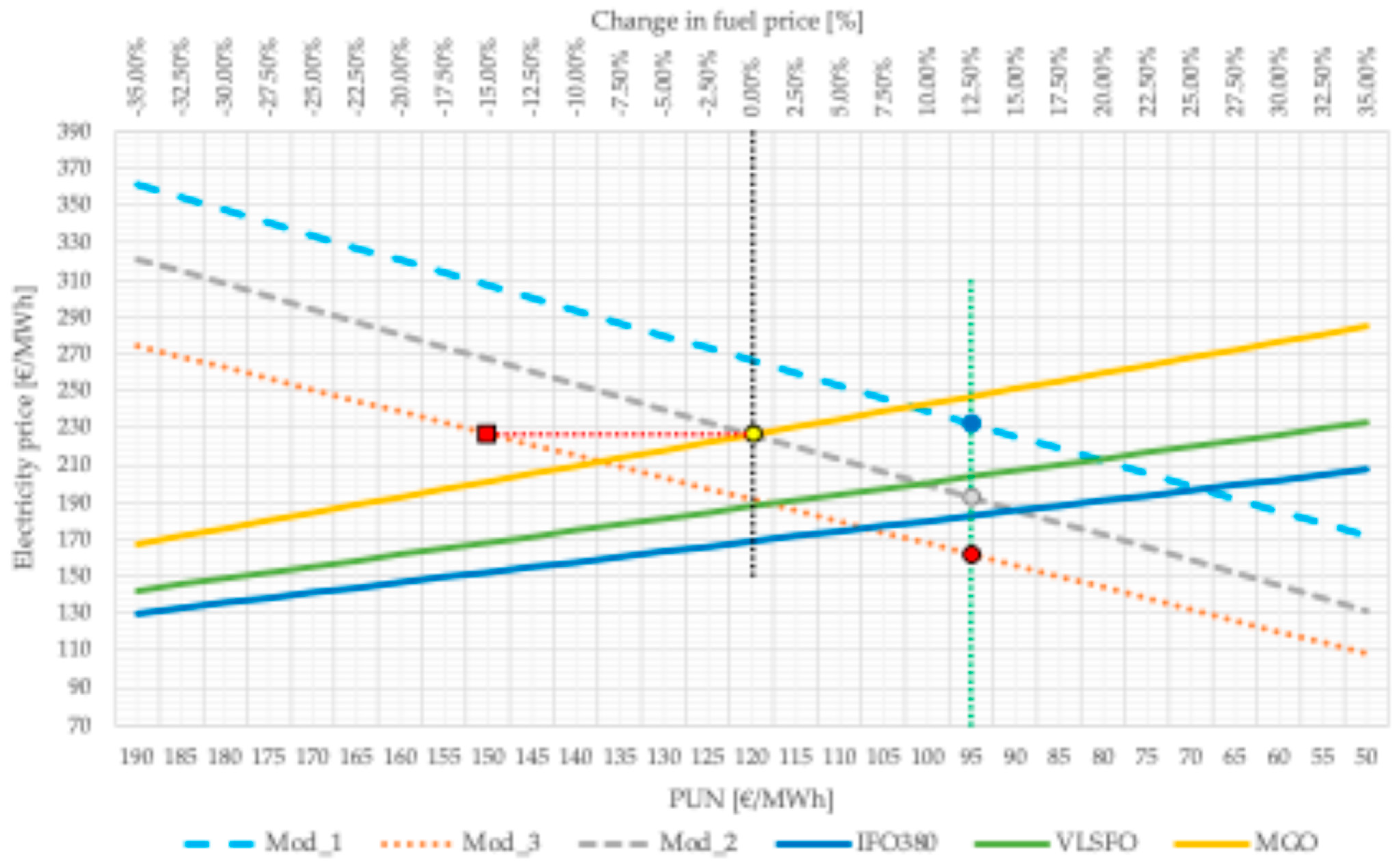
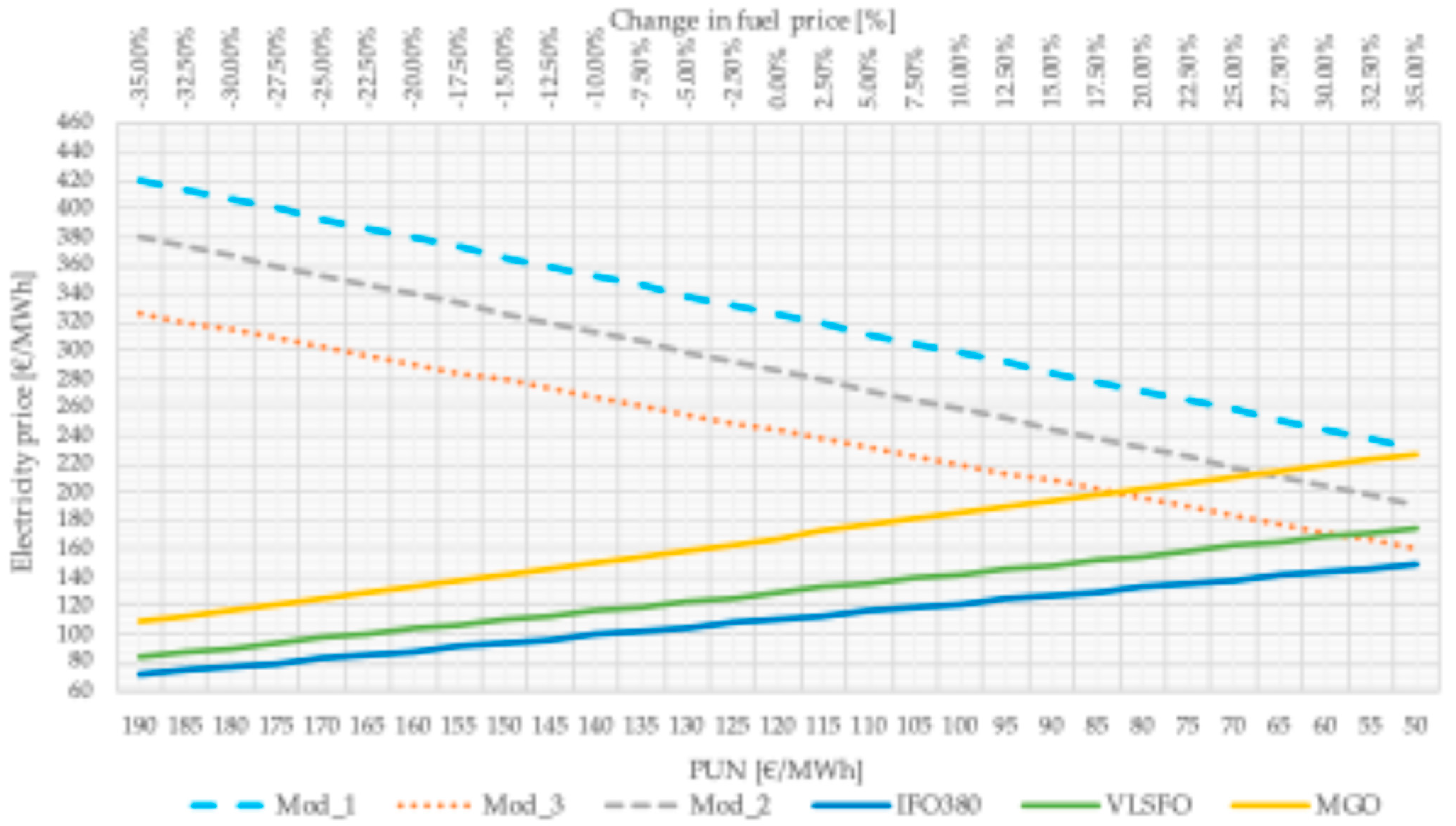

| Type | Supply Voltage [kV AC] | Maximum Load [MVA] |
|---|---|---|
| Cruise | 6.6–11 | 16–20 |
| Liquefied Natural Gas Carriers | 6.6 | 10.7 |
| Container Ships | 6.6 | 7.5 |
| Roll-on/roll-off Ships | 6.6–11 | 6.5 |
| Tankers | 6.6 | 3.6 |
| Type | Power Cables Excluding Any Neutral Cable | Signal Cables |
|---|---|---|
| Cruise | 4 | 2 |
| LNG carrier | 3 | 1 |
| Container Ships | 2 | Absent |
| Roll-on/roll-off Ships | 1 | Absent |
| Tankers | 2/3 | Absent |
| Payments | MPE Spot Market | MTE Forward Market |
|---|---|---|
| Access charge (one-off) | EUR 7500 | EUR 7500 |
| Fixed annual fee | EUR 10,000 | EUR 10,000 |
| Energy Traded on a Monthly Basis [TWh] | MPE [EUR/MWh] | MTE [EUR/MWh] |
|---|---|---|
| <0.02 | 0.00 | 0.01 |
| 0.02 ÷ 1 | 0.04 | 0.01 |
| 1 ÷ 10 | 0.03 | 0.01 |
| >10 | 0.02 | 0.01 |
| Voltage Level | Percentage Rate of Network Loss |
|---|---|
| 380 [kV] | 0.70% |
| 220 [kV] | 1.10% |
| High Voltage < 150 [kV] | 1.80% |
| Medium Voltage | 3.80% |
| Low Voltage | 10% |
| Type of Supply | Amount [cEUR/kWh] | ||
|---|---|---|---|
| Domestic uses | First home with contract power up to 3 kW First home with contract power up to 3 kW First home with higher contract power Other residences (second homes) | Up to 150 kWh/month Beyond 150 kWh/month | 0 2.27 2.27 2.27 |
| Street lighting | Supplies with any level of consumption | 1.25 | |
| Other uses | Up to 1200 MWh/month Beyond 1200 MWh/month | First 200 MWh/month Beyond 200 MWh/month First 200 MWh/month Beyond 200 MWh/month | 1.25 0.75 1.25 EUR 4820 (fixed) |
| Cold ironing | With installed capacity exceeding 35 kW | Law 8/2020 art. 34-bis | 0.05 |
| Vessel | Estimated Power Consumption in Port Cold Area Running on Own Generators [MW] | Estimated Power Consumption in Port Warm Area Running on Own Generators [MW] | Estimated Gallons ULSD of Fuel Used at Berth if Shore Power Was Not Available [gallons p/h] |
|---|---|---|---|
| Vessel 1 | 8 | 10 | 435–621 |
| Vessel 2 | 10 | 12.5 | 660–820 |
| Vessel 3 | 3.6 | 6 | 243–409 |
| Vessel | SFOC (Medium) [g/kWh] | SFOC (Cold Area) [g/kWh] | SFOC (Warm Area) [g/kWh] |
|---|---|---|---|
| Vessel 1 | 220.08 | 203.98 | 232.96 |
| Vessel 2 | 246.75 | 247.59 | 246.09 |
| Vessel 3 | 254.78 | 253.22 | 255.72 |
| Calculation Hypothesis | |
|---|---|
| Ships that can be connected in 2026 | 80% |
| Ships that can be connected but will not be connected in 2026 | 5% |
| Increase in traffic | 2% |
| Mooring duration | 9.5 [h] |
| Average power required | 10 [MW] |
| Load power factor | 0.9 |
| Voltage/Load frequency | Equal to 2025 |
| Load distribution between docks | Equal to 2025 |
| Dock 1 | Dock 2 | Total |
|---|---|---|
| 167 Of which 21.20% are without simultaneity with dock 2 | 127 Of which 7.59% are without simultaneity with dock 1 | 294 Of which 71.20% have simultaneous occupation of the docks |
| Voltage/Frequency | Dock 1 | Dock 2 |
|---|---|---|
| 11 [kV]/50 [Hz] | 0 (0.00%) | 0 (0.00%) |
| 6.6 [kV]/50 [Hz] | 0 (0.00%) | 0 (0.00%) |
| 11 [kV]/60 [Hz] | 167 (100.00%) | 122 (96.00%) |
| 6.6 [kV]/60 [Hz] | 0 (0.00%) | 5 (4.00%) |
| Case | Description | Number | Probability |
|---|---|---|---|
| 1 | Moorings at Dock 1 (11 [kV], 60 [Hz]) | 62.37 | 21.20% |
| 2 | Moorings at Dock 2 (11 [kV], 60 [Hz]) | 21.44 | 7.29% |
| 3 | Moorings at Dock 2 (6.6 [kV], 60 [Hz]) | 0.89 | 0.30% |
| 4 | Moorings at Dock 1 (11 [kV], 60 [Hz]) and in Dock 2 (11 [kV], 60 [Hz]) | 201.06 | 68.36% |
| 5 | Moorings at Dock 1 (11 [kV], 60 [Hz]) and in Dock 2 (6.6 [kV], 60 [Hz]) | 8.38 | 2.85% |
| 6 | Time duration with no ships connected | 6960.51 [h] | |
| Case | Load 60 [Hz] | POUT [MW] | PIN [MW] | Time [h] | EOUT [MWh] | EIN [MWh] |
|---|---|---|---|---|---|---|
| 1 | Dock 1–11 [kV] | 10 | 10.83 | 592.50 | 5925.15 | 6417.08 |
| 2 | Dock 2–11 [kV] | 10 | 10.84 | 203.65 | 2036.50 | 2208.38 |
| 3 | Dock 2–6.6 [kV] | 10 | 11.12 | 8.49 | 84.85 | 94.38 |
| 4 | Dock 1–11 [kV] + Dock 2–11 [kV] | 2 × 10 | 21.57 | 955.05 | 19,100.93 | 20,598.15 |
| 5 | Dock 1–11 [kV] + Dock 2–6.6 [kV] | 2 × 10 | 21.86 | 39.80 | 795.87 | 869.79 |
| 6 | No connected ships | - | 0.14 | 6960.51 | - | 967.99 |
| Total | 27,943.30 | 31,155.77 | ||||
| Average annual performance of the plant | 89.69 | % | ||||
| Element | Description | Value | Notes |
|---|---|---|---|
| ARERA | Tariffs for transmission, distribution, and metering | Data from 2023 | Latest published values |
| ARERA | General system charges | Null and ex-ante approach | In the analysed case study, the port facility is entirely dedicated to cold ironing. The model developed guarantees that the benefit is passed on to the shipowner (a concern repeatedly expressed by ARERA), i.e., the determination of the price per MWh requested by the port facility operator will be based on the imposition of a certain profit margin. By reducing the costs incurred to generate a certain revenue set by the margin, the benefit is passed on in accordance with the aforementioned national laws. |
| GME | PUN | Variable depending on the scenario | |
| GME | Target market | MGP | |
| GME | Participation fee | According to values in Table 3 and Table 4 | |
| GME | Amount requested by the energy trader | According to Equation (2) | |
| Management models | Licence fee (Model 1 e Model 2) | Estimated at EUR 200,000.00 | |
| Management models | Profit margin (Model 1 e Model 2) | 15% | Before tax |
| Management models | Safety margin (Model 3) | 3% | Before tax |
| Management models | Operating costs (e.g., for software) | Estimated at EUR 3500.00 | |
| Management models | E1 value (from Equation (2)) | 93.6 [TWh] | It is assumed that the plant is managed by a trader that produced 207.3 [TWh] and sold 300.9 [TWh] in 2023. Then, the value of E1 (i.e., the quantity purchased on the electricity market) would be 93.6 [TWh] [37]. |
| Additional expenditure items | Routine maintenance | EUR 180,000.00 | Estimated value based on the value of electrical systems dedicated to cold ironing. |
| Additional expenditure items | Extraordinary maintenance | EUR 45,000.00 | Value assumed equal to 25% of routine maintenance and referring to the annual average amount allocated to cover breakdowns and malfunctions not covered by insurance (estimation in the absence of historical data for cold ironing systems). |
| Additional expenditure items | Number of employees in the port | 11 | A pair of employees are considered as always present on duty, working 8 h shifts, without the need for overtime. |
| Additional expenditure items | Gross annual salary | EUR 35,100.00 | |
| Additional expenditure items | Annual insurance | EUR 150,000.00 | Estimated value based on the cost of the systems and equipment used. |
| Element | Description | Value | Notes |
|---|---|---|---|
| Fuel consumption | SFOC | 220 [g/kWh] | Equal to the minimum of the average values shown in Table 8 (precautionary approach). |
| Fuel cost | Reference value for MGO, varying according to the scenario | 825.00 [USD/mt] | [38] |
| Fuel cost | Reference value for VLSFO, varied according to the scenario | 635.50 [USD/mt] | [38] |
| Fuel cost | Reference value for IFO380, varied according to the scenario | 543.00 [USD/mt] | [38] |
| Physical parameter | Fuel density | 0.991 [kg/dm3] | This means that 1 tonne of fuel is equivalent to 1009.082 litres. |
| Economic parameter | Currency conversion | USD 1 = EUR 0.9248 | Average annual value of the dollar against the euro according to the Bank of Italy; report generated on 30/04/2024 [39]. |
| Economic parameter | Cost of emission of one tonne equivalent of CO2 | EUR 85 | Assumptions underlying the calculations. |
| Calculation Assumptions | |
|---|---|
| Type of plant | Dedicated entirely to cold ironing |
| User type | Cruise ships only |
| Required connection power | 22 [MW] |
| Standoff voltage | 150 [kV] |
| Energy sold | Estimated at 27,943.30 [MWh] |
| Average annual plant efficiency | Assumed to be 88.5% |
| Information | Value | Supporting Data |
|---|---|---|
| Distance considered | 308.00 [km] | Source: Google Maps |
| Connection time | 9.50 [h] | Value used in the calculation |
| Power at open sea | 62.40 [MW] | Generic value applicable to a cruise ship [41] |
| Power at docking | 11,163.00 [kW] | In accordance with Figure 3 |
| Ship weight | 153,816.00 [tonnes] | Generic value applicable to a cruise ship [41] |
| Average speed | 22 [knots] | Generic value applicable to a cruise ship [41] |
| Speed conversion | 1 [knot] = 1.852 [km/h] | |
| SFOC | 220 [g/kWh] | Value used in the calculation |
| Item | Cost (EUR) |
|---|---|
| Transformer | 200,000 |
| Central control panel | 100,000 |
| Wiring | 3000 |
| Cable reel system | 152,000 |
Disclaimer/Publisher’s Note: The statements, opinions and data contained in all publications are solely those of the individual author(s) and contributor(s) and not of MDPI and/or the editor(s). MDPI and/or the editor(s) disclaim responsibility for any injury to people or property resulting from any ideas, methods, instructions or products referred to in the content. |
© 2025 by the authors. Licensee MDPI, Basel, Switzerland. This article is an open access article distributed under the terms and conditions of the Creative Commons Attribution (CC BY) license (https://creativecommons.org/licenses/by/4.0/).
Share and Cite
Bignucolo, F.; Visentin, M.; De Pieri, D.; Augello, C.; Faggioni, N. Technical and Economic Feasibility of Cold Ironing in Italy: A Detailed Case Study. Energies 2025, 18, 5950. https://doi.org/10.3390/en18225950
Bignucolo F, Visentin M, De Pieri D, Augello C, Faggioni N. Technical and Economic Feasibility of Cold Ironing in Italy: A Detailed Case Study. Energies. 2025; 18(22):5950. https://doi.org/10.3390/en18225950
Chicago/Turabian StyleBignucolo, Fabio, Marco Visentin, Davide De Pieri, Carlo Augello, and Nicolò Faggioni. 2025. "Technical and Economic Feasibility of Cold Ironing in Italy: A Detailed Case Study" Energies 18, no. 22: 5950. https://doi.org/10.3390/en18225950
APA StyleBignucolo, F., Visentin, M., De Pieri, D., Augello, C., & Faggioni, N. (2025). Technical and Economic Feasibility of Cold Ironing in Italy: A Detailed Case Study. Energies, 18(22), 5950. https://doi.org/10.3390/en18225950






